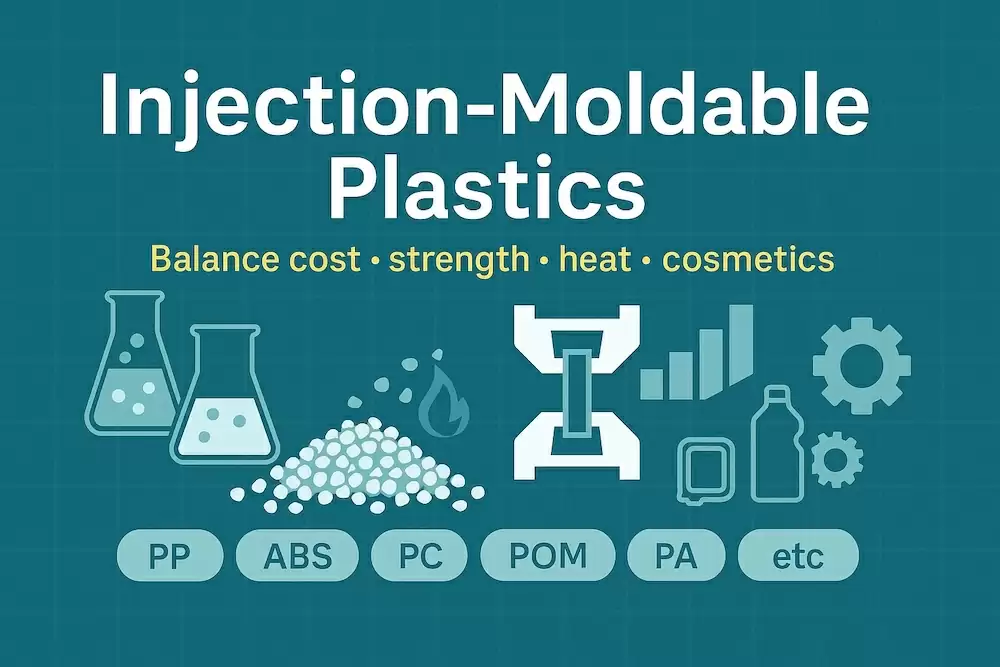Assess Injection-Moldable Plastics for Balanced Product Design
Assess Injection-Moldable Plastics for Balanced Product Design

Assess Injection-Moldable Plastics for Property Balances in Product Design
Picking the “best” plastic isn’t about a single headline spec. It’s about balancing properties—mechanical, thermal, chemical, optical, regulatory, and process—against cost and risk. This guide shows a practical, engineering-first way to shortlist and validate resins for injection-molded parts.
A 7-Step Resin Selection Workflow
-
Define CTQs (Critical-to-Quality).
Stiffness/impact targets, operating temp, chemicals/UV, flame rating, clarity, wear, color/texture, regulatory. -
Map constraints.
Wall limits, flow length, knit-line visibility, allowable draft, gate locations, assembly method (screws, weld, overmold). -
Choose a candidate family.
Commodity (PP/PE/HIPS) → cost; Engineering (ABS/PC/POM/PA/PBT/PETG) → performance; High-heat (PEEK/PPS/PEI) → extreme environments. -
Narrow by grade.
Impact-mod., glass/mineral filled, FR (UL 94), UV-stabilized, food-contact, medical, color masterbatch. -
Model processing risk.
Shrink/warp, moisture sensitivity, flow, surface class, weld-line locations, texture. -
Prototype in real resin.
One-off or low-volume tools to verify fit/finish/CTQs under a scientific-molding window. -
Lock the golden recipe.
Cavity pressure, V/P transfer, cooling, and inspection plan (CpK at CTQs).
Quick Property Map (Qualitative)
| Resin | Cost | Stiffness | Impact @ Low-T | Heat (HDT) | Chem. Resist. | Clarity | Notes / Typical Uses |
|---|---|---|---|---|---|---|---|
| PP (HPP/ICP/RCP) | Low | Med | Med–High (ICP) | Low–Med | High | RCP translucent | Living hinges, caps, bins, appliance internals |
| HDPE | Low | Med-Low | Med | Low–Med | High | Opaque | Containers, lids, chemical contact |
| ABS | Med | Med–High | Med | Med | Med | Opaque | Glossy housings, paintable A-class |
| PC/ABS | Med–High | Med–High | High | Med–High | Med | Opaque | Tough interior bezels, appliances |
| PC | High | High | High | High | Med | Clear | Clear guards/windows, impact lenses |
| PMMA | Med | Med | Low–Med | Med | Med | Best clarity / scratch | Light pipes, displays (less tough than PC) |
| POM (Acetal) | Med | Med–High | Med | Med | High (fuels, oils) | Opaque | Low-friction gears, slides, snaps |
| PA6/66 (Nylon) | Med | Med–High | Med | Med–High | Med | Opaque | Clips, carriers; dry before molding |
| PA-GF (30%) | Med–High | Very High | Med-Low | High | Med | Opaque | Structural brackets, fans, under-hood |
| PBT-GF | Med–High | High | Med | High | High | Opaque | Motor covers, connectors |
| PETG | Med | Med | Med | Med | Med | Clear, easy to mold | Clear covers/guards, good cosmetics |
| TPE/TPV | Med | Low | High (soft) | Low | High | Translucent | Overmold grips, seals |
| PEEK/PPS/PEI | Very High | Very High | High | Very High | High | Opaque | High-heat/chemical, aerospace/medical |
Qualitative ranges vary by grade, filler, and process window.
Common “Property Balance” Playbooks
-
High gloss + impact (A-class interior): PC/ABS (option: RHCM tooling for paint-free gloss).
-
Clear + tough: PC; if scratch priority > toughness → PMMA; for easy molding → PETG.
-
Chemical + fatigue + low friction: POM (gears, cams, slides).
-
Low cost + hinge/snap: PP (HPP for hinges, ICP for low-temp impact).
-
Dimensional stability + stiffness: Mineral-filled PP or PA/PBT with GF.
-
High heat + structural: PA66-GF30 or PBT-GF; extreme → PEEK/PPS.
-
Soft-touch over rigid: TPE/TPV over PP/PC/ABS (bond chemistry matched).
-
UV/weatherable exterior: ASA or UV-stabilized PP/TPO.
Processing Effects You Must Account For
-
Fillers change anisotropy. Glass fiber boosts modulus and HDT but lowers impact and drives warp along flow—align gates with load paths.
-
Mineral fillers (talc/CaCO₃) tame shrink and improve cosmetics, at lower impact than GF.
-
Moisture-sensitive resins (PA, PET, PBT) need proper drying to avoid splay/embrittlement.
-
Mold temperature & RHCM elevate surface quality, reduce weld-line read-through, and stabilize dimensions for PC/ABS/PC.
-
Color/ΔE control requires consistent melt temps, residence time, and masterbatch ratios.
-
Regrind policies affect impact and cosmetics—set limits by application (often 5–20% for non-critical parts).
Design Rules That Preserve the Balance
-
Uniform walls with ribs at 40–60% of wall thickness; core out thick sections.
-
Draft: ≥ 1.0–1.5° textured, ≥0.5° polished; more on deep ribs/cores.
-
Bosses: ID ≈ 60–70% OD; fillet bases; tie into walls with ribs.
-
Gates & knit lines: keep off A-class faces; use sequential valves on large skins.
-
Snap-fits: generous flex length and fillets; fatigue-test on PP/PC/POM candidates.
-
Overmold bonds: specify substrate grade and TPE chemistry; validate with peel/shear tests and seam vision.
Cost Tiers (Rule-of-Thumb)
-
Value: PP, HDPE, HIPS
-
Mid: ABS, POM, PA (unfilled), PETG
-
Upper-Mid: PC/ABS, PC, PA-GF, PBT-GF, ASA
-
Premium/High-Heat: PEEK, PPS, PEI (ULTEM™)
Final part cost also depends on cycle time, scrap, finishing, and yield—often more than raw resin price.
Shortlist Recipes by Use Case
| Use Case | Shortlist | Notes |
|---|---|---|
| Kitchenware lids / hinges | PP (HPP/RCP) | Flow across hinge; hinge 0.25–0.50 mm |
| Appliance bezels (glossy) | PC/ABS, ABS | RHCM or higher mold temp for weld-free gloss |
| Window/guard (clear & tough) | PC | Hard-coat if scratch critical |
| Gears/sliders | POM | Low friction; consider PTFE-mod grades |
| Under-hood bracket | PA66-GF30, PBT-GF | Dry thoroughly; gate for fiber orientation |
| Outdoor trim | ASA, UV PP/TPO | Weatherable; texture hides read-through |
| Soft grip over rigid | TPE over PP/PC/ABS | Match bond chemistry; control seam |
| Chemical contact | POM, PP, HDPE | Verify media list & temperature |
Validation Plan (Right-Sized)
-
Metrology: FAIR + CMM/blue-light on CTQs, GR&R for gauges.
-
Functional: snap torque, hinge cycle, creep, clip retention, wear tests.
-
Environmental: thermal cycle, humidity soak, chemical splash per use case, UV.
-
Cosmetics: ΔE color, gloss, weld-line/kiss-off mapping under defined lighting.
-
Process capability: establish golden recipe; demonstrate CpK at CTQs.
What We Do (TaiwanMoldMaker.com Network)
-
48-Hour DFM Pack: gate/vent/cooling plan + risk map and cycle model.
-
Material & grade recommendation matched to CTQs, cost, and supply chain.
-
Prototype → bridge → series tools: aluminum, hybrid, and full steel.
-
Automated cells: valve-gated hot runners, vision SPC, MES dashboards (OEE, CpK, scrap).
-
Sector quality: ISO 9001 network; IATF 16949 / ISO 13485 / AS9100 available at select plants.
RFQ Template (Copy/Paste)
Subject: RFQ – Resin Assessment & Injection-Molded Part
Attachments: STEP/IGES + 2D drawings with CTQs highlighted
-
Part name / revision:
-
Annual volume & first order qty:
-
Operating environment: (temp range, chemicals, UV, sterilization)
-
Priority properties: (impact, stiffness, clarity, heat, friction, flame, etc.)
-
Cosmetic class & texture codes: (A/B/C, SPI)
-
Assembly method: (screws, weld, overmold, adhesives)
-
Compliance needs: (UL 94, RoHS/REACH, FDA/USP Class VI, automotive PPAP)
-
Preferred materials (if any):
-
Inspection pack: (FAIR, CMM, ΔE, capability)
-
Target dates & Incoterms:
Related Services & Quick Links
-
Custom Mold & Design Maker
https://www.taiwanmoldmaker.com/product/custom-mold -
Mold Service
https://www.taiwanmoldmaker.com/product/mold-service -
Injection Mold
https://www.taiwanmoldmaker.com/product/injection-mold -
Customer Examples
https://www.taiwanmoldmaker.com/product/customer-examples
Call to Action
Need help balancing properties for your next molded part? Send CAD and CTQs to receive a 48-Hour DFM & Cost Pack plus a grade shortlist tailored to your tests, cosmetics, and budget.
Request an Instant Quote → https://www.taiwanmoldmaker.com/contact








